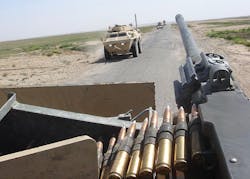Army wants vehicle-protection systems that detect incoming enemy fire and shoot back automatically
Officials of the Army Research, Development and Engineering Command (RDECOM), Communications-Electronic Research, Development and Engineering Center (CERDEC) at Aberdeen Proving Ground, Md., have issued a source-sought notice (W56KGU14RA002) for the Modular Active Protection Systems (MAPS) for an Active Protection Tracking Sensor program.
The program is trying to find companies with the technology and know-how to develop tracking sensor technologies capable of detecting, tracking, and classifying ground direct-fire threats to military vehicles.
The idea is to improve the process determining the enemy, his location, and the kind of ammunition he's shooting to speed the ability of U.S. and allied vehicles under attack to shoot back and neutralize the threat.
Army researchers are interested in tracking sensors that work while vehicles are parked or moving, with 360-degree coverage. The sensors should be compatible with common vetronics architectures and controllers, and forward detection and tracking information to onboard weapons to return fire quickly.
This project seeks to help compensate for a lack of military vehicle situational awareness, help military vehicle crews shoot back quickly and effectively when under attack. An active protection system able to detect, track, classify, and counter an incoming threat would reduce damage and casualties, Army officials say.
These sensors and countermeasures should enable modularity and scalability for current and future sensors, countermeasures, vehicles, and threat solutions, researchers say.
Related: Perimeter security uses advanced sensors to provide fail-safe intrusion detection
Those interested should respond by U.S. mail, postmarked no later than 22 June 2014, to U.S. Army, RDECOM, CERDEC, Intelligence and Information Warfare Directorate (I2WD); ATTN: RDER-IWR-RS (MAPS Tracker); 6005 Combat Dr Bldg 6003; Aberdeen Proving Ground, MD, 21005.
Email questions or concerns to [email protected]. More information is online at https://www.fbo.gov/notices/3448be3b6c020ddb5e9bb791bef2b039.
